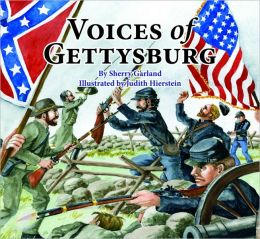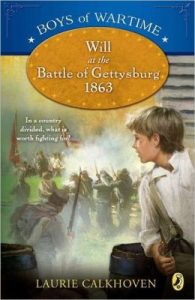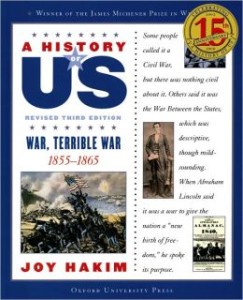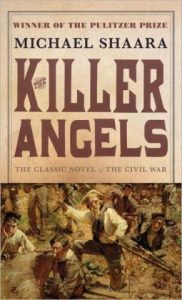One hundred and fifty years ago, two great armies collided in a small Pennsylvania town. The actual site of the battle was not planned, but the overall strategy had been in the southern commander’s mind for at least a month, and by it he hoped to deal one last blow to the Army of the Potomac, capitalize on anti-war sentiment in the North (as depicted in the recent movie Copperhead), and make a physically superior but demoralized enemy give up on the war. The plan was bold, psychologically sound, and it might have worked. Some historians and Civil War buffs see Pickett’s Charge as the turning point of the whole war, and thereby of American history—which is probably an exaggeration, but there’s no denying the drama of Gettysburg. This week the two armies are colliding again (Gettysburg is re-enactor heaven), and I’m searching the library stacks for good books on the subject. There are a number of series nonfiction books that will relate the facts in a straightforward manner with plenty of illustrative backup, but I haven’t yet found the true, enduring Gettysburg novel for kids. Some are pretty good, though, and if you have teenagers who are halfway interested in history there’s one Gettysburg novel they must read.
Voices of Gettysburg, by Sherry Garland, illustrated by Judith Hierstein. Pelican  Publishing Company, 2010, 38 pages. Age/interest level: 7-11.
Publishing Company, 2010, 38 pages. Age/interest level: 7-11.
Many if not most of these “voices” are from historical figures, but their words are made up by the author. She’s done her homework, though. From June 3, when Robert E. Lee began his march to Pennsylvania, to June 1872, when the Ladies Memorial Association of Richmond reclaimed the bodies of the Confederate dead, these witnesses put together a dramatic story. Alternating between blue and gray, officers and enlisted men, military and civilian, the tension of those days builds, sometimes hour by hour. And there’s no talk of politics. The book was published in the south, by southerners who may want to play down the slavery angle, but still: testimony from soldiers who survive any war make it clear that politics is the last thing on their minds before or during combat. When the guns are blazing, you’re mostly concerned about staying alive or supporting your comrades or, when all else fails, dying well. The thoughts of a woman pressed into nursing the wounded capture the wrenching pathos:
I hastily write down their final words,
promising them I will tell their wives and mothers
or sisters or sweethearts that they died like men.
I will cry tomorrow; I do not have time to cry today.
- Worldview/moral value: 3.5
- Literary value: 4
 Will at the Battle of Gettysburg (Boys of Wartime, #2) by Laurie Calkhoven. Dutton, 2011, 229 pages (including author’s note, chronology, list of historical characters, etc.). Age/interest level: 9-13.
Will at the Battle of Gettysburg (Boys of Wartime, #2) by Laurie Calkhoven. Dutton, 2011, 229 pages (including author’s note, chronology, list of historical characters, etc.). Age/interest level: 9-13.
Ever since his brother Jacob enlisted in the Union Army, Will Edmonds, 13, has daydreamed about becoming an army drummer. His mother would never tolerate it, but he’s practicing anyway. One thing for sure: he’d have to run away to get into the action, because nothing will ever happen in boring little Gettysburg. Until the day those Confederate cavalrymen charged into town, firing shots and raising Cain and screaming their infernal rebel yell. When they round up a bunch of free blacks and threaten to sell them down south, Will can’t help himself. He charges into the situation with his big mouth and might have got himself thrown in jail or shot if a boy his own age hadn’t saved his bacon. Abel Hoke is a reb, but not a demon in disguise. In fact, they could become good friends if it weren’t for what started on July 1.
Nice character development and plot pacing make this story a good choice for middle-grade readers. Since we see everything through Will’s eyes, we don’t get a bird’s-eye view of the battle, but rather total confusion, during which Will is believably confused. For the backstory, a couple of conversations with Abel and a Union officer lay out in natural and understandable terms why the war was fought, and demonstrate that there were decent people on both sides.
- Worldview/moral value: 4
- Literary value: 3.5
A History of US: War, Terrible War 1855-1865, by Joy Hakim. Oxford University Press,  2003, 168. Age/interest level: 10-16.
2003, 168. Age/interest level: 10-16.
As you might infer from the title, this is one volume in the History of US series, originally published in 1993 and still the most readable U.S. history for kids that I’ve come across. For the most part, the author steers clear of revisionism and sticks pretty close to the facts, while adding those fascinating personality quirks and oddities that make history so interesting. Battlefield tactics and strategies get their due, but we don’t get there until halfway into the book: there’s a lot of buildup to go through first, including John Brown and the Underground Railroad and life stories of the key players—also lots of pictures, maps, and period photos. All that background sets the stage for four years of bloodshed, including the Battle of Gettysburg, chapter 23. Appendices include Songs of the Civil War, Chronology of main events, and maps of the world of 1860.
- Worldview/moral value: 3
- Literary value: 4
 The Killer Angels, by Michael Shaara. Originally published 1974, McKay; several editions, about 400 pages long. Age/interest level: 15-up.
The Killer Angels, by Michael Shaara. Originally published 1974, McKay; several editions, about 400 pages long. Age/interest level: 15-up.
Civil War fans adore this book—considered not only the best Gettysburg novel but maybe even the best war novel ever. That’s debatable, and so is the author’s romanticizing of certain key players, but he accomplished something extremely rare and difficult: making historical figures seem like real people living in a real time with thoughts they might actually have thought. All the major characters are historical, and both sides of the story unfold through their eyes: chiefly General James Longstreet for the south and Colonel Joshua Lawrence Chamberlain of the north. Chamberlain gives the novel its heroic climax on Little Round Top, day two of the battle. Though historians debate the importance of this action, and Chamberlain’s role in it, Little Round Top and the monument to Chamberlain’s 20th Maine have become the top stop for tourists on the Gettysburg Battlefield tour. That scene certainly made my heart beat faster the first time I read it, but what made me cry was Lewis Armistead’s recollection of a West Point officers’ reunion before former comrades split up to fight for the blue or the gray.
Chamberlain also gives the novel its title, as he recalls a conversation with his father about Hamlet’s line, What a piece of work is man! In action how like an angel . . . Grumbles Chamberlain Sr., “Well boy, if he’s an angel, he’s sure a murderin’ angel.” Allusions to Shakespeare and the Bible abound, with every shade of reverence and doubt and some profanity. But any teen who is warned to steer around the infrequent bad language might gain as clear a sense of this conflict as any 21st-century reader could–not only the carnage and sorrow, but also of the adrenalin rush that makes some men reenlist.
- Worldview/moral value: 3.5
- Literary value: 5
Support our writers and help keep Redeemed Reader ad-free by joining the Redeemed Reader Fellowship.
Stay Up to Date!
Get the information you need to make wise choices about books for your children and teens.
Our weekly newsletter includes our latest reviews, related links from around the web, a featured book list, book trivia, and more. We never sell your information. You may unsubscribe at any time.
We'd love to hear from you!
Our comments are now limited to our members (both Silver and Golden Key). Members, you just need to log in with your normal log-in credentials!
Not a member yet? You can join the Silver Key ($2.99/month) for a free 2-week trial. Cancel at any time. Find out more about membership here.
1 Comments
Leave a Comment
You must be logged in to post a comment.


I just saw this today. Was helpful for me understanding the Battle of Gettysburg.
https://www.smithsonianmag.com/history-archaeology/A-Cutting-Edge-Second-Look-at-the-Battle-of-Gettysburg.html